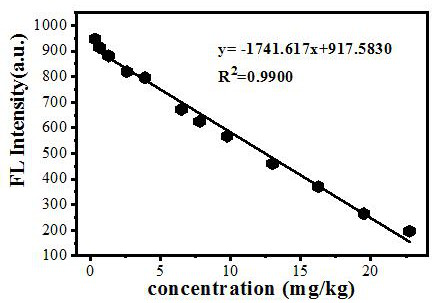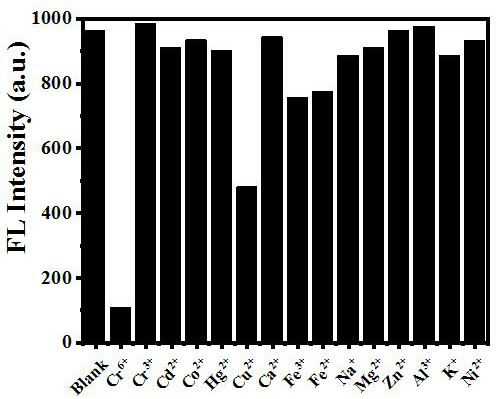Method for rapid fluorescence detection of chromium content
A technology for fluorescence detection and chromium content, which is applied in the field of chemical analysis and detection, can solve problems such as chromium pollution reduction or degradation, human health damage, and restrictions on the development of aquaculture industry, and achieve increased specificity, strong selectivity, and improved stability. Effect
- Summary
- Abstract
- Description
- Claims
- Application Information
AI Technical Summary
Problems solved by technology
Method used
Image
Examples
Embodiment 1
[0024] Example 1: Determination of Cr(Ⅵ) and Cr(Ⅲ) in environmental water samples
[0025] 1. Preparation of fluorescent probe: Mix 2 mL of 5 mmol / L histamine solution with 1 mL of 5 mmol / L tyramine solution, then add 5 mL of fluorescamine with a mass volume concentration of 0.02%, 3 mL of pH=8 phosphate buffer solution, and 1 mL of deionized water , vortexed for 1 min, and allowed to stand for 5 min to obtain a fluorescent probe solution;
[0026] 2. Creation of Cr(Ⅵ) working curve: add 100 µL of fluorescent probe and Cr(Ⅵ) standard solution into a 5 mL stoppered colorimetric tube, mix well and let stand for 3 minutes, dilute to 4 mL with deionized water, and mix well, in which Cr(Ⅵ) (Ⅵ) The concentration range in the stoppered colorimetric tube is 0.1-25mg / kg. Under the excitation wavelength of 390nm, the fluorescence intensity is measured at the wavelength of 488nm. For the fluorescence spectrum of Cr(Ⅵ) standard solution, see figure 1 , with the concentration of Cr(Ⅵ) as ...
Embodiment 2
[0039] Embodiment 2: Determination of Cr (Ⅵ) and Cr (Ⅲ) in soil
[0040] 1. Preparation of fluorescent probes
[0041] Mix 3mL of 5mmol / L histamine solution with 1mL of 5mmol / L tyramine solution, then add 6mL of fluorescamine with a mass volume concentration of 0.02%, 4mL of pH=8 phosphate buffer solution, 2mL of deionized water, vortex for 2min, and let stand 8min, obtain fluorescent probe solution;
[0042] 2. The production of Cr(Ⅵ) working curve is the same as in Example 1;
[0043] 3. Determination of Cr(Ⅵ) and Cr(Ⅲ) content in soil samples
[0044] (1) Sample treatment: Weigh 5g of soil, wash twice with 50mL acetone, then rinse with water, and dry at 30°C, then weigh 1.0g of dry soil, wash with 100mL HNO 3 ( 63%, m / v) and 50mL H 2 o 2 (30%, m / v) was dissolved, and reacted at 150±5°C for 2h, then washed with acid until nearly dry, and removed insoluble matter with a 0.22μm polytetrafluoroethylene filter membrane, took 5mL of the filtrate, and dilute it to 50mL with ...
Embodiment 3
[0047] Embodiment 3: the mensuration of chromium content in tap water sample
[0048] 1. Preparation of fluorescent probes
[0049] Mix 4 mL of 5 mmol / L histamine solution with 1 mL of 5 mmol / L tyramine solution, then add 7 mL of fluorescamine with a mass volume concentration of 0.02%, 5 mL of pH=8 phosphate buffer solution, 1.5 mL of deionized water, vortex for 1 min, and let Place for 10min to obtain the fluorescent probe solution;
[0050] 2. Cr ( ) Working curve making: with embodiment 1;
[0051] 3. Determination of Cr(Ⅵ) and Cr(Ⅲ) content in tap water: the operation is the same as in Example 1, and Cr(Ⅵ) and Cr(Ⅲ) were not detected;
[0052] Cr ( ) and Cr ( ) content determination method has the characteristics of simple operation, high sensitivity and rapidity, does not require large-scale equipment, and has strong advantages in actual detection.
PUM
 Login to View More
Login to View More Abstract
Description
Claims
Application Information
 Login to View More
Login to View More - R&D
- Intellectual Property
- Life Sciences
- Materials
- Tech Scout
- Unparalleled Data Quality
- Higher Quality Content
- 60% Fewer Hallucinations
Browse by: Latest US Patents, China's latest patents, Technical Efficacy Thesaurus, Application Domain, Technology Topic, Popular Technical Reports.
© 2025 PatSnap. All rights reserved.Legal|Privacy policy|Modern Slavery Act Transparency Statement|Sitemap|About US| Contact US: help@patsnap.com



